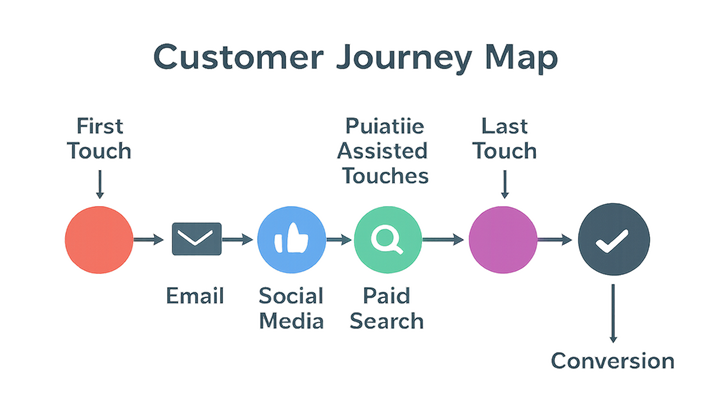Published on 2025-06-28T09:06:17Z
What Are Assisted Conversions? Examples and Insights
Assisted conversions represent the number of times a marketing channel contributed to a conversion before the final interaction that led to the purchase or goal completion. They help marketers understand how different channels support the user journey beyond last-click credit, revealing the full impact of email, social, display, and other touchpoints. In multi-touch attribution models such as those used by Google Analytics 4 and PlainSignal’s privacy-first analytics, assisted conversions are counted whenever a user interaction influences a conversion without being the final click. By analyzing assisted conversions, businesses can allocate budgets more effectively, optimize underappreciated channels, and foster cross-channel collaboration. Tracking assisted conversions requires consistent tagging, event tracking, and accurate attribution settings to ensure every touchpoint is captured. This comprehensive view helps teams build more balanced marketing strategies that recognize the value of every customer interaction.
Assisted conversions
Non-last-click interactions credited for conversions, offering insight into each channel’s supportive role in multi-touch journeys.
What Are Assisted Conversions?
This section defines assisted conversions and differentiates them from last-click conversions within the analytics industry. It explores their role in understanding channel interactions and the concept of multi-touch attribution.
-
Definition of assisted conversions
Assisted conversions represent any non-final interaction by a marketing channel that contributes to a conversion. These interactions can include clicks or engagements from email, social media, display ads, and more.
-
Assisted vs last-click conversions
While last-click conversions attribute full credit to the final user interaction, assisted conversions capture the supportive touchpoints earlier in the funnel. This distinction enables a more balanced view of channel performance.
-
Role in multi-touch attribution
In a multi-touch attribution model, assisted conversions help distribute credit across multiple interactions according to the chosen attribution rule. They reveal how early and middle-funnel channels influence purchase decisions.
Why Do Assisted Conversions Matter?
This section highlights the importance of analyzing assisted conversions for comprehensive marketing insights. It discusses how this metric influences budget allocation, channel optimization, and overall ROI.
-
Holistic channel evaluation
Assisted conversions ensure that no channel is overlooked by including contributions from all touchpoints, not just the final one.
-
Optimized budget allocation
By recognizing the value of assisted interactions, marketers can rebalance spend across channels that indirectly drive conversions.
-
Improved attribution accuracy
Including assisted conversions reduces bias toward last-click data, leading to a more accurate understanding of the customer journey.
Examples of Assisted Conversions in Analytics Tools
Illustrative examples of how assisted conversions are tracked and reported in leading analytics platforms like Google Analytics 4 and PlainSignal.
-
Google analytics 4 (GA4)
In GA4, assisted conversions appear under Acquisition reports: navigate to Acquisition > Traffic acquisition and look for the ‘Assisted conversions’ metric. GA4 also provides ‘Assisted conversion value’ to show revenue influenced by supporting channels.
-
Assisted conversions metric
Shows the count of conversions where a channel assisted at least once without being the last click.
-
Assisted conversion value
Displays the total monetary value attributed to a channel’s assists based on your defined conversion values.
-
-
PlainSignal
PlainSignal’s cookie-free analytics tracks assisted conversions by capturing user interactions across sessions using a privacy-first approach. You can implement tracking with the following snippet:
<link rel="preconnect" href="//eu.plainsignal.com/" crossorigin /> <script defer data-do="yourwebsitedomain.com" data-id="0GQV1xmtzQQ" data-api="//eu.plainsignal.com" src="//cdn.plainsignal.com/plainsignal-min.js"></script>-
Implementation
Insert the PlainSignal snippet into your site’s head section to begin capturing assisted interactions.
-
Reporting
View assisted conversions in PlainSignal’s dashboard under the ‘Conversions’ and ‘Attribution’ sections.
-
Best Practices for Tracking Assisted Conversions
Guidelines for setting up and interpreting assisted conversion data to ensure accuracy and actionable insights.
-
Implement consistent event tracking
Define and tag all relevant conversion events consistently across channels to ensure every touchpoint is captured.
-
Choose the right attribution model
Select or customize an attribution model that aligns with your business goals, whether linear, time decay, or position-based.
-
Regularly audit and validate data
Perform routine audits to check for tracking errors, missing tags, or discrepancies between tools.
-
Combine assisted conversions with roi metrics
Pair assisted conversion counts with revenue or cost data to assess the true value each channel adds.
